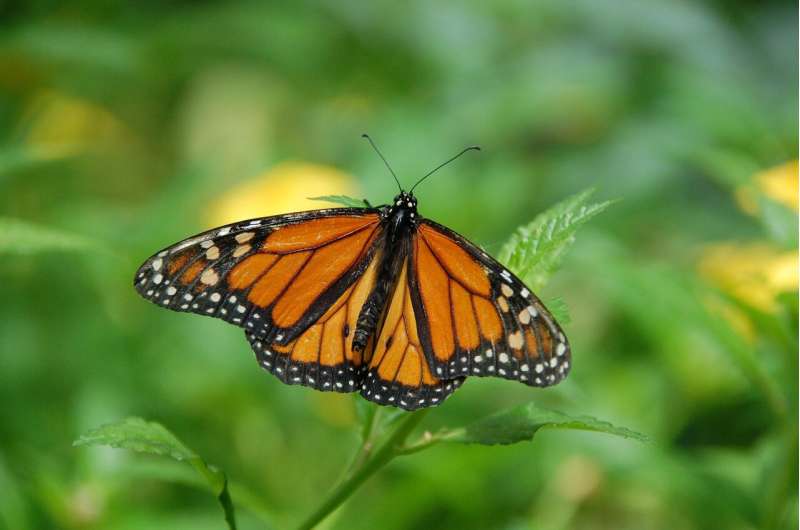California county sees highest number of monarch butterflies in more than 20 years

There's some hope fluttering around San Luis Obispo County this holiday season.
It comes in the form of an iconic orange-and-black striped butterfly that makes tall eucalyptus or Monterey cypress trees its home up and down the coast.
More than 129,000 western monarch butterflies were counted in the county by Xerces Society for Invertebrate Conservation employees and volunteers in November, according to preliminary data shared by local volunteer coordinator Jessica Griffiths.
That's the most counted in San Luis Obispo County in more than 20 years—in 1998 there were about 182,000 counted, according to the Xerces Society's data.
The numbers are giving some researchers hope that the western monarch butterfly population could be rebounding from devastatingly low numbers a few years ago that left some worrying the insect was on the verge of extinction.
"It's really encouraging," Griffiths said of the latest counts. "I'm personally so delighted by it."
The high counts of overwintering monarch butterflies in the county echoes a statewide theme.
According to the Xerces Society, more than 300,000 of the insects were tallied during its annual Thanksgiving count, which ran from Nov. 12 through Dec. 4 this year. That is the highest total since 2000, when more than 390,000 were counted, Xerces data show.
Last year, about 247,000 monarch butterflies were counted statewide, 92,000 of those in San Luis Obispo County, according to the Xerces Society.
That was a huge jump from data collected in 2020 when counters found just 2,000 of the butterflies overwintering across the entire state.
It's hard to tell exactly why there are more monarch butterflies fluttering around overwintering groves, Griffiths said.
Part of that is because there are simply more groves being counted: 55 sites were surveyed in San Luis Obispo County this year, she said, up from 51 last year. That number has been rising nearly every year as community members keep an eye out for the insects and report them to the Xerces Society.
The biggest overwintering groves in the county include the Pismo Beach Monarch Butterfly Grove along Highway 1, along Pecho Road in Los Osos, at the Morro Bay Golf Course, within the Fiscalini Ranch Preserve and scattered around dozens of private properties, according to the Xerces Society.
The Xerces Society's efforts are important in understanding how many monarch butterflies migrate to San Luis Obispo County and other coastal areas in California every winter before fluttering away to breed, Griffiths said.
"We need accurate data to really target restoration efforts," she said. "And right now, I think we're seeing it's working—we're seeing them rebound."
But even with the recent rebound, scientist including Griffiths are always quick to temper their enthusiasm, as the monarch butterfly population is still considered on the verge of collapse.
Monarch butterflies were recently considered endangered by the renowned International Union for Conservation of Nature. In its assessment, the organization noted that climate change and habitat destruction were two major contributors to the species decline.
In 2014, about 235,000 western monarch butterflies were counted in California. That same year, the Xerces Society and other conservation groups filed a petition with the U.S. Fish and Wildlife Service to request the agency list monarchs on the federal Endangered Species List.
That petition is still being considered by the federal government.
Monarchs are designated as imperiled and vulnerable by the California Department of Fish and Wildlife. That means the insects cannot be handled, removed from the wild or otherwise taken for scientific or propagation purposes without a permit, according to the agency.
Restoration efforts by the Xerces Society and other conservation groups include planting milkweed and nectar plants and protecting overwintering sites and summer habitats from being destroyed.
In San Luis Obispo County, Griffiths noted that people living in inland areas at least five miles from the coast such as San Luis Obispo, Atascadero and Templeton, should plant milkweed plants to help feed the insects. Native milkweeds in California include woolypod, California, heartleaf, narrowleaf and showy milkweed.
Those living along the coast and closer to overwintering sites should plant nectar plants that bloom in the fall, winter and spring to help feed the butterflies while they're overwintering as well as while they fly away to breed.
Native nectar plants that monarchs like include goldenrod, sunflowers, bluedicks, seaside fleabane, coyotebrush, mulesfat, desertbroom, rabbitbrush, goldenbush, mock heather, manzanita and willow, according to the Xerces Society.
(c)2022 The Tribune (San Luis Obispo, Calif.)
Distributed by Tribune Content Agency, LLC.




















